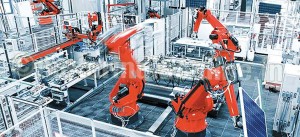 VDMA Robotics + Automation is one of the 39 sub-sectors within VDMA and unites more than 240 members-companies providing components and systems from the areas of robotics, integrated assembly solutions (formerly assembly and handling technology) and machine vision. The objective of this industry-driven platform is to support the robotics and automation sector through a wide spectrum of activities and services. A total of 42 member-companies from the Robotics + Automation sector are involved in the Blue Competence initiative of VDMA, the German Engineering Federation.
VDMA Robotics + Automation is one of the 39 sub-sectors within VDMA and unites more than 240 members-companies providing components and systems from the areas of robotics, integrated assembly solutions (formerly assembly and handling technology) and machine vision. The objective of this industry-driven platform is to support the robotics and automation sector through a wide spectrum of activities and services. A total of 42 member-companies from the Robotics + Automation sector are involved in the Blue Competence initiative of VDMA, the German Engineering Federation.
Sustainability has long been a guiding principle of the action taken by the mechanical engineering industry. Many of the technical innovations aim to conserve resources. The German mechanical engineering industry offers solutions which, due to optimized energy efficiency, consistent process optimization and the use of secondary raw materials, make a massive contribution to reducing life cycle costs.
Compared with 1998-2000, companies in Germany save almost EUR 7 billion a year by using modern machinery and equipment. By 2022, the annual potential saving is expected to be as high as EUR 20 billion. These figures clearly illustrate that sustainability does not just have an ecological and social dimension, but also has an economic impact.
However, there has not been a common platform up till now. This platform was brought into being in 2011 with the Blue Competence initiative by VDMA. Over 400 companies have now joined this initiative. To become a partner, companies must prove that they have introduced sustainable production processes in their plants and that they manufacture products that conserve the environment and its resources. The number of members is growing steadily. That is because more and more customers want to buy machines that have been developed in accordance with sustainability criteria, and therefore save money. Blue Competence alliance members develop cutting-edge technology “Made in Germany” that combines sustainability with economy.
A case study contributed by VITRONIC Dr.-Ing. Stein Bildverarbeitungssysteme GmbH Hasengartenstr shows that camera-based welded seam inspection helps make the welding process more efficient. Automatic inspection eliminates the need for time-consuming retouching and increases the quality of the finishing process. Automated welded seam inspection forms the basis for optimizing welding processes.
Automatic welding is a standard technology in today‘s industrial manufacturing world. Well-installed facilities achieve good results. Unfortunately, the human eye cannot detect gradual decreases in welding quality with consistent reliability. The resulting need for retouching uses additional energy and sometimes creates scrap wasting resources.
Without automated inspection, it can take a long time to notice when the quality of the welding process starts decreasing, as manual inspection doesn‘t take place objectively according to fixed quality criteria. When defective welded seams aren‘t detected, this can lead to costly disruptions in production and even to product recalls.
The VIROwsi optical seam inspection system not only automatically recognizes defects, but also delivers immediate warnings based on customizable limits for different testing criteria. The machine operator can immediately take action to re-optimize the welding process. Thus energy is saved, as less retouching means less energy use. Also, resources are protected, as quick interventions in the production process lead to less scrap.
Practical experience has shown that an integrated analysis of the welding process allows the entire welding process to be perfected, resulting in the same end quality with less effort needed for testing and inspection.
For details, visit: www.bluecompetence.net